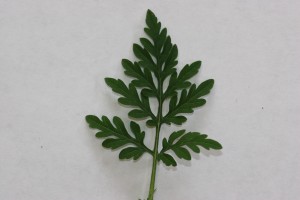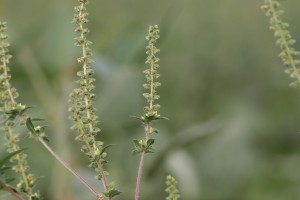
Common ragweed – Ambrosia artemisiifolia
Ambrosia artemisiifolia L.
Asteraceae (Aster family)
MI Status
Native
Life cycle
Erect, branching summer annual.
Leaves
Cotyledons are thick and oval to spatula-shaped. Leaves are fernlike, once or twice compound and usually hairy. Upper leaves are alternate; lower leaves may be opposite or alternate with distinct petioles.
Stems
Usually hairy, erect and branched up to 6 feet tall.
Flowers and fruit
Flowers are generally inconspicuous, found on terminal branches. They produce prolific amounts of pollen. The seed is enclosed in a single-seeded, woody fruit with several spikes resembling a crown.
Reproduction
Seeds.
Similar weeds
Giant ragweed (A. trifida L.)
Differs by having cotyledons three to four times larger; three- to five-lobed leaves opposite in arrangement; and a height that may reach 15 feet.
Western ragweed (A. psilostachya DC.)
Differs by having a perennial nature with prolific creeping roots, densely hairy leaves and a height typically not above 4 feet.






 Print
Print Email
Email